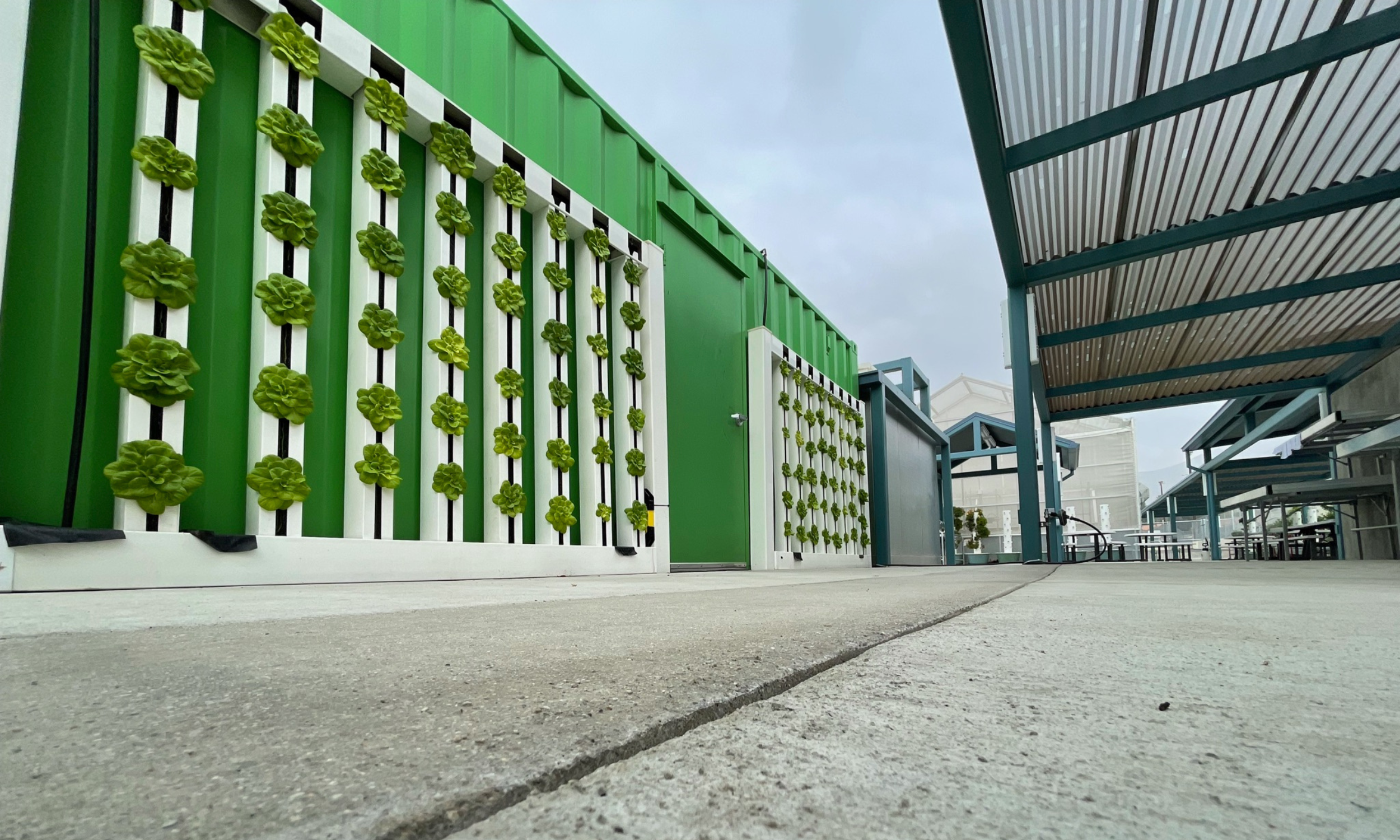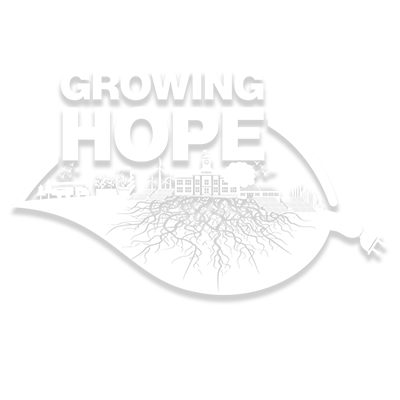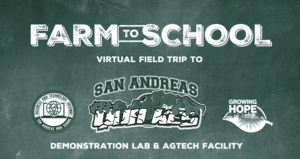
Climate Smart • Ag tech • Workforce • education • Sustainability
WHO We are
Growing Hope Project (GHP) believes in the power of partnerships… Partnerships that empower our youth and communities to create a better future! We are proud to be an innovative leader with a unique approach to building a future workforce. By integrating green tech, community development, and business, our Career Technical Education Pathway provides K-14 students with opportunities to learn leadership, entrepreneurship, and cross-curricular collaboration. The Growing Hope Project takes people with various challenges, needs, and backgrounds and focuses on preparing them for skills they will need in climate-resilient careers in the future.
Embracing the power of HOPE to motivate and drive change in people’s lives while fostering and creating equitable access in partnership with the organizations and leaders we work with in the community.
GHP Building Blocks
The Growing Hope Project (GHP) incorporates experiential and engaging learning environments to facilitate creative and collaborative problem-solving. Our Building Blocks fit around the Strong Workforce Program’s Demand Industry Sector, “Agriculture, Water & Environmental Technologies.” Simultaneously, we ask the following four questions revolving around the Life Cycle of Energy:
How do we create or harvest energy?
What are we converting it to (i.e. work)?
How does this impact us & our community (health and wellness)?
Finally, what do we do with it after we use it? and How can we conserve it (recycle and regenerate)?
-
Simply put, energy is “the ability to do work.” It’s one of the few true constants of the universe. No matter its formation (e.g. water, renewables, carbon or data), energy can be found everywhere. What’s even more amazing, energy can neither be created nor destroyed; it simply transfers from one configuration to the next. When creating an educational experience for students, we begin with any one or more of the four questions:
• How do we harvest it?
• How do we convert it?
• How does it impact us?
• What do we do with it or conserve it?
-
The Growing Hope Project uniquely fits within the Strong Workforce Program’s (SWP) Agriculture, Environmental & Water Technologies Industry Sector. SWP builds on the Department of Labor’s Workforce Innovation and Opportunity Act (WIOA), and the Department of Education’s state Adult Education Block Grant and public school CTE programs. These programs aim to lift low-wage workers into living-wage jobs for Californians while offering exposure to career pathways that incorporate educational standards and certifications with occupational opportunities.
-
Growing Hope Project aims to incorporate academic standards like Next Generation Science Standards, Basics3 for Special Education, Common Core and more. It strives to offer opportunities for students and teachers to co-creating learning experiences, incorporating technology-based education, big-picture project-based collaboration, and tailored lessons based on a student’s skill set.
-
Keeping accessibility in mind has been a very important aspect of the program. We believe projects like this can improve the quality of life for all involved. Therefore, we have taken a great deal of time, thought, and consideration to have accessibility for not only general education students but alternative education, English learners, and the Special Education student population—simultaneously.
Energy Cycle
Mini - Documentary
Brandon and Alejandro are one of the first founding students that the Growing Hope Project selected for a paid student internship. They clocked over 600 hours of work, learning, project, and driver education training as well as helping them navigate the FAFSA and Community College application process.
Change Your Energy. Change Your Life.
“"Agriculture can help solve the climate crisis - or it can make it worse... The future of food and agriculture is the future of the planet."
— Dr. David Nabarro, Special Representative of the UN Secretary-General for Food Security and Nutrition
Climate Smart Agriculture
Climate smart agriculture is a sustainable farming approach that aims to enhance productivity, build resilience, and reduce greenhouse gas emissions. It involves the use of innovative practices, such as conservation agriculture, integrated pest management, and efficient irrigation systems, to ensure that farming activities are environmentally friendly and socially equitable.
Climate smart agriculture also recognizes the importance of preserving natural resources, such as soil, water, and biodiversity, to ensure the long-term viability of agricultural systems. By adopting climate smart agriculture practices, farmers can mitigate the impacts of climate change on their livelihoods and contribute to global efforts to reduce greenhouse gas emissions.
Controlled Environment Agriculture (CEA)
Controlled environment agriculture (CEA) is a farming technique that involves the use of advanced technology and management practices to create a favorable environment for growing crops in an enclosed space. CEA relies on a combination of artificial lighting, temperature control, humidity control, and air flow to create optimal growing conditions for plants. This technique enables farmers to grow crops year-round, regardless of weather conditions, and in locations where traditional agriculture may not be possible. CEA is highly efficient, as it minimizes water usage and reduces the need for pesticides and fertilizers. Additionally, the controlled environment allows for precise monitoring and management of the crops, leading to increased yields and higher quality produce. CEA is increasingly being recognized as a sustainable alternative to traditional agriculture, as it offers significant benefits in terms of food security, environmental sustainability, and economic viability.
Agrivoltaics
Controlled environment agriculture agrivoltaics is a farming technique that combines the use of renewable energy and advanced technology to create a highly efficient and sustainable form of agriculture. This approach involves the co-location of solar panels and indoor farming facilities, such as hydroponic or aeroponic systems, to maximize the use of available resources. The solar panels can help to power the facility, while also providing shade and reducing water loss through evaporation. The indoor farming facility can be highly efficient, using minimal water and energy while producing high yields of crops.
Additionally, the controlled environment allows for precise monitoring and management of the crops, leading to increased yields and higher quality produce. This approach to agriculture is highly sustainable, as it reduces the environmental impact of traditional farming and minimizes the use of non-renewable resources. Controlled environment agriculture agrivoltaics is an exciting area of research and development, with the potential to revolutionize the way we produce food and generate energy.
Entrepreneurship
Entrepreneurship in ag tech involves using innovative technologies to solve challenges in the agricultural industry. This includes developing new solutions for improving crop yields, reducing environmental impacts, and increasing the efficiency of farming operations. Ag tech entrepreneurs leverage cutting-edge technologies such as artificial intelligence, robotics, and precision agriculture to create new products and services that can benefit farmers and consumers alike. These entrepreneurs are often driven by a desire to improve sustainability and food security, while also creating new business opportunities. The ag tech industry is rapidly growing, with increasing investment and interest from both established companies and new startups. This presents an exciting opportunity for entrepreneurs to make a significant impact in the agricultural sector, while also driving economic growth and innovation.
our Ecosystem
Through our unique approach to solving clients’ challenges, we have developed a comprehensive approach to helping underserved individuals reach their potential from a Green Tech and AgTech lens. We have four different areas that we utilize, from cradle to career.
WORKFORCE DEVELOPMENT
We build social mobility from cradle to career by providing access to work-based learning opportunities and exposure to technology and resources that they need to gain the skills needed for careers in the climate-resilient economy.
Farm 2 School
Learn the concepts behind what you eat, a community’s food ecosystem, the technology behind fresh food, the impact of climate change on farming, and more during a hands-on virtual 6-week program.
SmartGreens
Female, minority-owned hydroponic farm using climate-smart technology growing methods with an inclusive approach to growing leafy greens and herbs for the community.
Growing Hope Foundation
A community based organization founded to help underserved individuals have workforce development opportunities in Growing Hope Project or similar organizations.
OUR PROJECTS
Our focus is on projects that serve and change the lives of under-resourced and disadvantaged populations. The Growing Hope Project team is passionate about a holistic and creative approach to site design and program design that is built for sustainability, experiential learning, and inspiring. For over 7 years, we have had the opportunity to work on various projects in the community that spark curiosity and engage community stakeholders and anchor institutions to collaborate toward a vision and build up community assets. In our years of experience and overcoming challenges, we have found a creative lens by focusing on the individual which helps provide an evolutionary and innovative sustainable future where workforce development, economic development, health, technology, and education intersect.

E NEAL ROBERTS ELEMENTARY
Flexible Demonstration Classroom and Outdoor Area utilizing AgTech, Sensors, robotics, and hydroponic and soil growing at an Elementary School. Designed for multiple classroom and community engagement.

NORTHSIDE
8.8 Acre Innovation and Urban Agricultural center designed to showcase multiple innovative farming methods and research that are climate-smart while facilitating community engagement, entrepreneurship, and beginning farmer incubation.

SAN ANDREAS
Alternative High School with an Demonstration Lab and Agtech Facility with a Commercial Capacity Greenhouse designed to grow up to 13,000 plants per cycle with Indoor and Outdoor Flexible Teaching Areas, Cold and Dry Storage and Open Event area












![[F2S] Week 7 Updates -Follow up from Final Activities, Program Finalization, Field Trips & Returning Items](https://images.squarespace-cdn.com/content/v1/636c1720905f7744dd0e6da0/1684881029892-9S0PRT9H611T5BJ5650R/week7.gif)